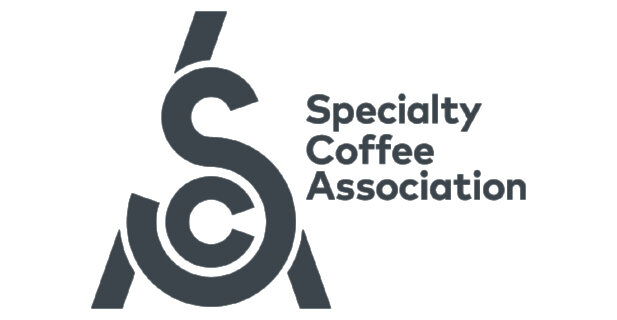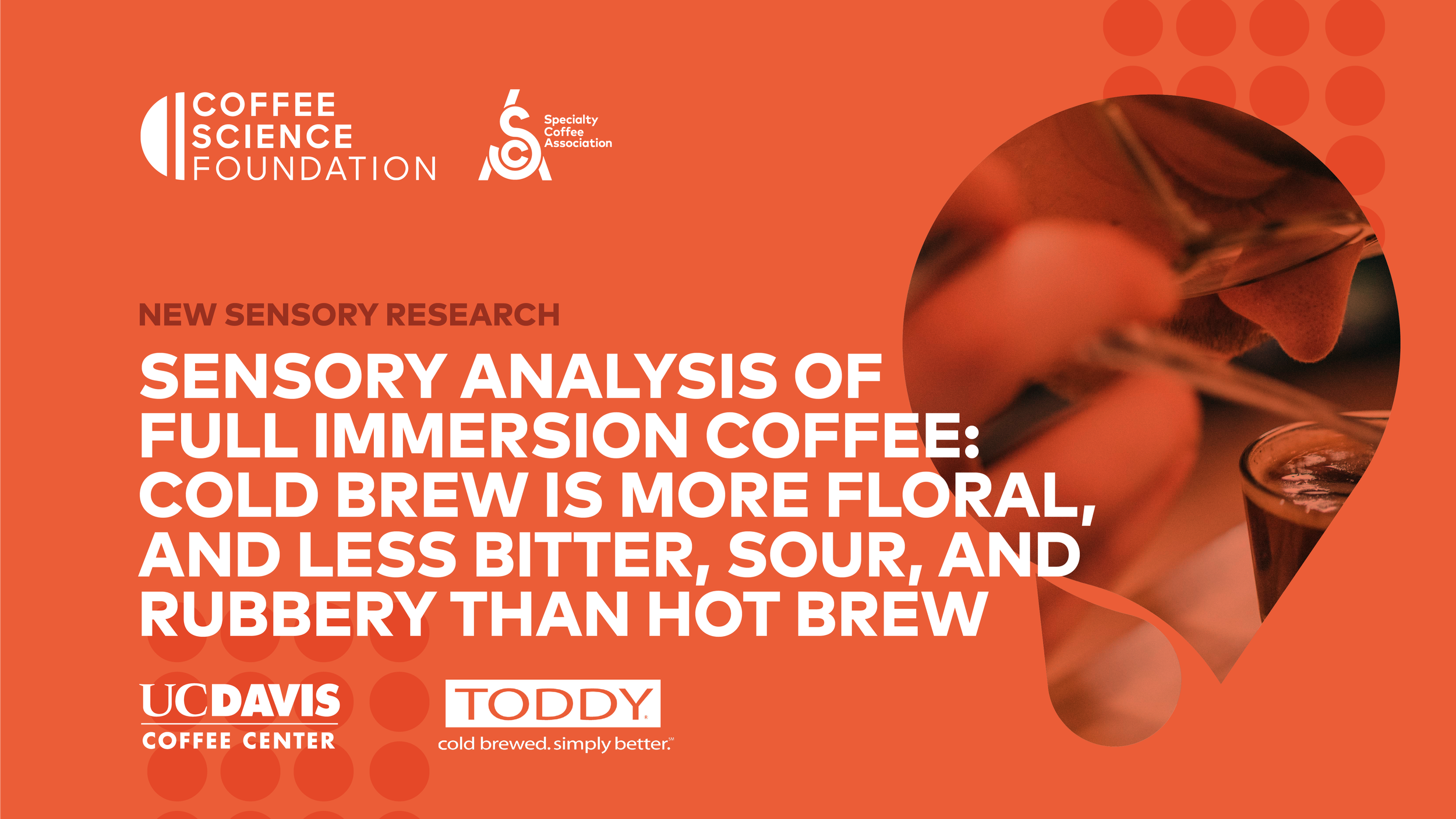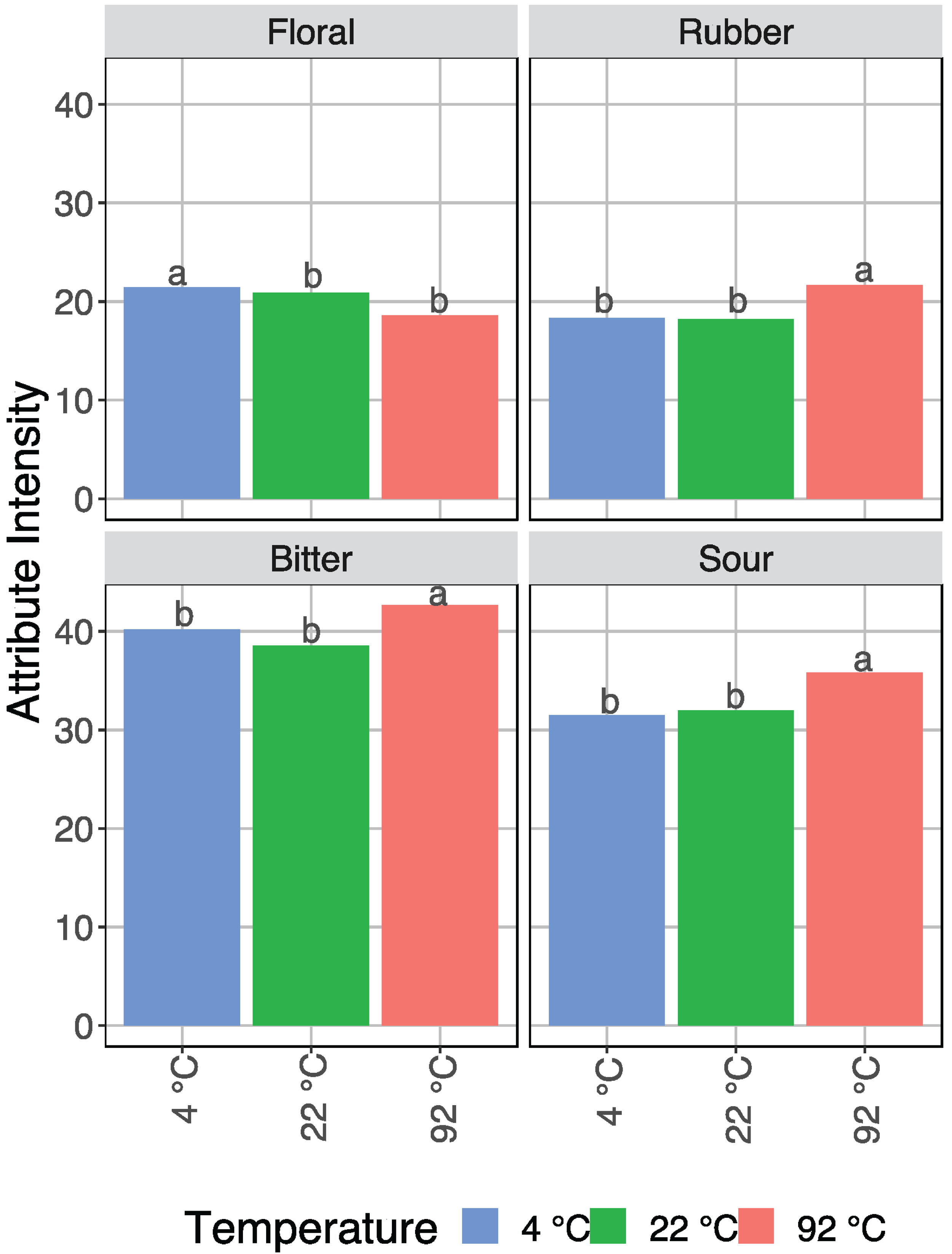The Coffee Science Foundation Announces New Cold Brew Extraction Research: Sensory Analysis of Full Immersion Coffee
A new publication has been released; entitled, “Sensory Analysis of Full Immersion Coffee: Cold Brew Is More Floral, and Less Bitter, Sour, and Rubbery Than Hot Brew,” the article was published in the journal, Food.
The Coffee Science Foundation alongside the Specialty Coffee Association is excited to announce this output from the Cold Brew Extraction research project. This project is underwritten by Toddy, LLC and the research related to this publication was performed by a research team led by DR. MACKENZIE BATALI, at the University of California, Davis.
This study found four sensory attributes which exhibited statistically significant variations in relation to brew temperature (variation were true for all origins and roast levels tested). Of the four, three attributes – bitter taste, sour taste, and rubber flavor – were all higher in hot brewed coffees, and one attribute – floral flavor – was higher in cold brewed coffee. However, it should be noted that there were several additional sensory attributes significantly impacted by temperature for specific origins and roast levels.
The methodology used was a 3 x 3 x 3 factorial design, with coffee from three different origins (El Salvador Cerro Las Ranas Honey varietals Bourbon, Pacamara, Sarchimor, Pacas, Catuai, and Caturra, an Ethiopia Guji Washed organic of indigenous heirloom varietals, and a Sumatra Fair-Trade Organic Takengon varietals Catimor, Tim Tim, and Abyssinia) representing different post-harvest methods (washed, honey-processed, and wet-hulled), each roasted to three different levels (light, medium, and dark), and each brewed at three different temperatures (4 °C, 22 °C, and 92 °C).
Figure 1. A schematic of the coffee brewing process and packaging for a remote COVID-19 descriptive analysis.
To maintain consistent sensory qualities across the test coffees, post-roasting treatment (roasted coffees allowed to degas for one week), storage (vacuum-sealed bags placed in a freezer maintained at -20 °C ) and brewing methods (brewed using Toddy Cupping Kits with Toddy paper filters) were kept consistent. Additionally, all coffees were brewed to equilibrium, then diluted to precisely 2% total dissolved solids (TDS) and served at the same cold temperature (4 °C)
Figure 4. Sensory attributes with significant differences by temperature across all roasts and origins with LSD letter codes indicating significant difference.
In addition to the four sensory attributes (bitter taste, sour taste, rubber flavor, and floral flavor) that varied consistently by brew temperature, each origin showed unique sensory differences due to temperature. The Ethiopia coffee across all roast levels showed a significantly higher burnt flavor in the 92 °C coffee than the 22 °C coffee or the 4 °C coffee. Conversely, fruity flavor was significantly higher in the 4 °C coffee than the 22 °C or the 92 °C coffee. The El Salvador coffee only had one additional attribute, woody flavor, that was significant across all roasts, which followed a slightly different trend: the 4 °C coffee had the highest woody intensity, the 22 °C coffee was significantly lower, and the 92 °C coffee was intermediate. The Sumatra coffee also had one significant attribute across all roasts, smoky flavor, which also followed a pattern similar but reversed to the El Salvador’s woody flavor. In the Sumatra coffee, the 92 °C coffee had the highest smoky flavor, with the 22 °C coffee significantly lower and the 4 °C coffee in the middle.
Overall, an analysis of the data revealed roast was the largest driver of difference among the coffees, with 20 attributes showing a significant difference by roast level. In general, the lighter roasts were more floral, fruity, and sour, whereas the darker roasts were more burnt, bitter, and roasted. Origin was the second largest driver of difference of the three experimental factors, with the analysis revealing 13 attributes that were significantly different by origin. The honey-processed El Salvador and washed Ethiopia coffees, for example, were generally more sour and fruitier than the wet-hulled Sumatra coffees, which were more vegetative and nuttier. Many of the differences by origin, however, were also dependent on the roast and brew temperature.
In conclusion, the research resulted showed that, at a fixed TDS and consumption temperature, brew temperature across the cold to hot range had a significant impact on the sensory attributes of coffee. The results presented also substantiate the general belief that cold brew is less sour, per descriptive analysis, but not necessarily less acidic chemically.
Synopsis by MARY BASCO, SCA Research and Knowledge Development Programs Manager.
“Sensory Analysis of Full Immersion Coffee: Cold Brew Is More Floral, and Less Bitter, Sour, and Rubbery Than Hot Brew,” an open-access article published in Food, was authored by Batali, M. E., Lim, L. X., Liang, J., Yeager, S. E., Thompson, A. N., Han, J., Ristenpart, W. D., & Guinard, J.-X.t.
This project was made possible thanks to generous underwriting from Toddy, LLC.
Batali, M. E., Lim, L. X., Liang, J., Yeager, S. E., Thompson, A. N., Han, J., Ristenpart, W. D., & Guinard, J.-X. (2022). Sensory analysis of Full Immersion Coffee: Cold Brew is more floral, and less bitter, sour, and rubbery than hot brew. Foods, 11(16), 2440.
References
National Coffee Data Trends Report. Available online: https://www.ncausa.org/Research-Trends/Market-Research/NCDT (accessed on 17 November 2021).
Is Cold Brew Coffee Less Acidic? (Surprise Answer Inside!). Available online: https://theoldcoffeepot.com/is-cold-brew-coffee-less-acidic/ (accessed on 19 February 2022).
Samoggia, A.; Riedel, B. Coffee Consumption and Purchasing Behavior Review: Insights for Further Research. Appetite 2018, 129, 70–81. [Google Scholar] [CrossRef] [PubMed]
Sensory Lexicon. World Coffee Research. Available online: https://worldcoffeeresearch.org/work/sensory-lexicon/ (accessed on 16 January 2020).
Spencer, M.; Sage, E.; Velez, M.; Guinard, J.-X. Using Single Free Sorting and Multivariate Exploratory Methods to Design a New Coffee Taster’s Flavor Wheel. J. Food Sci. 2016, 81, S2997–S3005. [Google Scholar] [CrossRef] [PubMed]
Clarke, R.J.; Macrae, R. Coffee: Volume 1: Chemistry; Springer: Amsterdam, The Netherlands, 1985. [Google Scholar]
Sunarharum, W.B.; Williams, D.J.; Smyth, H.E. Complexity of Coffee Flavor: A Compositional and Sensory Perspective. Food Res. Int. 2014, 62, 315–325. [Google Scholar] [CrossRef]
Bhumiratana, N.; Adhikari, K.; Chambers, E. Evolution of Sensory Aroma Attributes from Coffee Beans to Brewed Coffee. LWT-Food Sci. Technol. 2011, 44, 2185–2192. [Google Scholar] [CrossRef]
Lee, L.W.; Cheong, M.W.; Curran, P.; Yu, B.; Liu, S.Q. Coffee Fermentation and Flavor: An Intricate and Delicate Relationship. Food Chem. 2015, 185, 182–191. [Google Scholar] [CrossRef] [PubMed]
Seninde, D.R.; Chambers, E.; Chambers, D. Determining the Impact of Roasting Degree, Coffee to Water Ratio and Brewing Method on the Sensory Characteristics of Cold Brew Ugandan Coffee. Food Res. Int. 2020, 137, 109667. [Google Scholar] [CrossRef]
Cordoba, N.; Fernandez-Alduenda, M.; Moreno, F.L.; Ruiz, Y. Coffee Extraction: A Review of Parameters and Their Influence on the Physicochemical Characteristics and Flavour of Coffee Brews. In Trends in Food Science and Technology; Elsevier Ltd.: Amsterdam, The Netherlands, 2020; pp. 45–60. [Google Scholar] [CrossRef]
Klotz, J.A.; Winkler, G.; Lachenmeier, D.W. Influence of the Brewing Temperature on the Taste of Espresso. Foods 2020, 9, 36. [Google Scholar] [CrossRef]
Batali, M.E.; Ristenpart, W.D.; Guinard, J. Brew Temperature, at Fixed Brew Strength and Extraction, Has Little Impact on the Sensory Profile of Drip Brew Coffee. Sci. Rep. 2020, 10, 16450. [Google Scholar] [CrossRef]
Batali, M.E.; Frost, S.C.; Lebrilla, C.B.; Ristenpart, W.D.; Guinard, J. Sensory and Monosaccharide Analysis of Drip Brew Coffee Fractions versus Brewing Time. J. Sci. Food Agric. 2020, 100, 2953–2962. [Google Scholar] [CrossRef]
Batali, M.E.; Cotter, A.R.; Frost, S.C.; Ristenpart, W.D.; Guinard, J.-X. Titratable Acidity, Perceived Sourness, and Liking of Acidity in Drip Brewed Coffee. ACS Food Sci. Technol. 2021, 1, 559–569. [Google Scholar] [CrossRef]
Frost, S.C.; Ristenpart, W.D.; Guinard, J. Effects of Brew Strength, Brew Yield, and Roast on the Sensory Quality of Drip Brewed Coffee. J. Food Sci. 2020, 85, 2530–2543. [Google Scholar] [CrossRef] [PubMed]
Lingle, T.R. The Coffee Brewing Handbook: A Systematic Guide to Coffee Preparation, 2nd ed.; Specialty Coffee Association of America: Santa Ana, CA, USA, 2011. [Google Scholar]
Cotter, A.R.; Batali, M.E.; Ristenpart, W.D.; Guinard, J.-X. Consumer Preferences for Black Coffee Are Spread Over a Wide Range of Brew Strengths and Extraction Yields. J. Food Sci. 2020, 86, 194–205. [Google Scholar] [CrossRef] [PubMed]
Pangborn, R.M. Influence of Water Composition, Extraction Procedures, and Holding Time and Temperature on the Quality of Coffee Beverages. Leb. Technol. 1982, 15, 161–168. [Google Scholar]
Córdoba, N.; Moreno, F.L.; Osorio, C.; Velásquez, S.; Ruiz, Y. Chemical and Sensory Evaluation of Cold Brew Coffees Using Different Roasting Profiles and Brewing Methods. Food Res. Int. 2021, 141, 110141. [Google Scholar] [CrossRef] [PubMed]
Heo, J.; Choi, K.S.; Wang, S.; Adhikari, K.; Lee, J. Cold Brew Coffee: Consumer Acceptability and Characterization Using the Check-All-That-Apply (CATA) Method. Foods 2019, 8, 344. [Google Scholar] [CrossRef] [PubMed]
Angeloni, G.; Guerrini, L.; Masella, P.; Innocenti, M.; Bellumori, M.; Parenti, A. Characterization and Comparison of Cold Brew and Cold Drip Coffee Extraction Methods. J. Sci. Food Agric. 2019, 99, 391–399. [Google Scholar] [CrossRef]
Adhikari, J.; Chambers, E.; Koppel, K. Impact of Consumption Temperature on Sensory Properties of Hot Brewed Coffee. Food Res. Int. 2019, 115, 95–104. [Google Scholar] [CrossRef]
Chapko, M.J.; Seo, H.S. Characterizing Product Temperature-Dependent Sensory Perception of Brewed Coffee Beverages: Descriptive Sensory Analysis. Food Res. Int. 2019, 121, 612–621. [Google Scholar] [CrossRef]
Frost, S.C.; Ristenpart, W.D.; Guinard, J. Effect of Basket Geometry on the Sensory Quality and Consumer Acceptance of Drip Brewed Coffee. J. Food Sci. 2019, 84, 2297–2312. [Google Scholar] [CrossRef]
Lawless, H.T.; Heymann, H. Descriptive Analysis. In Sensory Evaluation of Food; Springer: New York, NY, USA, 2010; pp. 227–257. [Google Scholar] [CrossRef]
Coffee Processing Methods|Discover How Coffee Gets Made–Bean & Bean Coffee Roasters. Available online: https://beannbeancoffee.com/blogs/beansider/coffee-processing-methods (accessed on 8 May 2022).
Cotter, A.; Hopfer, H. The Effects of Storage Temperature on the Aroma of Whole Bean Arabica Coffee Evaluated by Coffee Consumers and HS-SPME-GC-MS. Beverages 2018, 4, 68. [Google Scholar] [CrossRef]
Liang, J.; Chan, K.C.; Ristenpart, W.D. An Equilibrium Desorption Model for the Strength and Extraction Yield of Full Immersion Brewed Coffee. Sci. Rep. 2021, 11, 6904. [Google Scholar] [CrossRef] [PubMed]
Czerny, M.; Grosch, W. Potent Odorants of Raw Arabica Coffee. Their Changes during Roasting. J. Agric. Food Chem. 2000, 48, 868–872. [Google Scholar] [CrossRef] [PubMed]
Costa Freitas, A.M.; Mosca, A.I. Coffee Geographic Origin-An Aid to Coffee Differentiation. Food Res. Int. 1999, 32, 565–573. [Google Scholar] [CrossRef]
Neves Barbosa, J.; Meira Borém, F.; Angelo Cirillo, M.; Ribeiro Malta, M.; Ângelo Cirillo, M.; Alves Alvarenga, A.; Maria Ramos Alves, H. Coffee Quality and Its Interactions with Environmental Factors in Minas Gerais, Brazil Coffee Quality and Its Interactions with Environmental Factors in Minas Gerais, Brazil The Research Is Financed by National Council for Scientific and Technological Development (CNPq) and Coordination for the Improvement of Higher Level (CAPES). J. Agric. Sci. 2012, 4, 181. [Google Scholar] [CrossRef]
Worku, M.; de Meulenaer, B.; Duchateau, L.; Boeckx, P. Effect of Altitude on Biochemical Composition and Quality of Green Arabica Coffee Beans Can Be Affected by Shade and Postharvest Processing Method. Food Res. Int. 2018, 105, 278–285. [Google Scholar] [CrossRef]
Decazy, F.; Avelino, J.; Guyot, B.; Perriot, J.J.; Pineda, C.; Cilas, C. Quality of Different Honduran Coffees in Relation to Several Environments. J. Food Sci. 2003, 68, 2356–2361. [Google Scholar] [CrossRef]
de Carvalho Neto, D.; de Melo Pereira, G.; Tanobe, V.; Thomaz Soccol, V.; G. da Silva, B.; Rodrigues, C.; Soccol, C. Yeast Diversity and Physicochemical Characteristics Associated with Coffee Bean Fermentation from the Brazilian Cerrado Mineiro Region. Fermentation 2017, 3, 11. [Google Scholar] [CrossRef]
Rodriguez, Y.F.; Guzman, N.G.; Hernandez, J.G. Effect of the Postharvest Processing Method on the Biochemical Composition and Sensory Analysis of Arabica Coffee. Eng. Agrícola 2020, 40, 177–183. [Google Scholar] [CrossRef]
Gonzalez-Rios, O.; Suarez-Quiroz, M.L.; Boulanger, R.; Barel, M.; Guyot, B.; Guiraud, J.-P.; Schorr-Galindo, S. Impact of “‘ecological’” Post-Harvest Processing on the Volatile Fraction of Coffee Beans: I. Green Coffee. J. Food Compos. Anal. 2007, 20, 289–296. [Google Scholar] [CrossRef]
De Bruyn, F.; Zhang, S.J.; Pothakos, V.; Torres, J.; Lambot, C.; Moroni, A.V.; Callanan, M.; Sybesma, W.; Weckx, S.; De Vuyst, L. Exploring the Impacts of Postharvest Processing on the Microbiota and Metabolite Profiles during Green Coffee Bean Production. Appl. Environ. Microbiol. 2017, 83, e02398-16. [Google Scholar] [CrossRef]
Vinícius de Melo Pereira, G.; Soccol, V.T.; Brar, S.K.; Neto, E.; Soccol, C.R. Microbial Ecology and Starter Culture Technology in Coffee Processing. Crit. Rev. Food Sci. Nutr. 2017, 57, 2775–2788. [Google Scholar] [CrossRef] [PubMed]
de Melo Pereira, G.V.; Soccol, V.T.; Soccol, C.R. Current State of Research on Cocoa and Coffee Fermentations. Curr. Opin. Food Sci. 2016, 7, 50–57. [Google Scholar] [CrossRef]
Mahmud, M.M.C.; Shellie, R.A.; Keast, R. Unravelling the Relationship between Aroma Compounds and Consumer Acceptance: Coffee as an Example. Compr. Rev. Food Sci. Food Saf. 2020, 19, 2380–2420. [Google Scholar] [CrossRef] [PubMed]
Breslin, P.A.S. Interactions among Salty, Sour and Bitter Compounds. Trends Food Sci. Technol. 1996, 7, 390–399. [Google Scholar] [CrossRef]
Keast, R.S.J. Modification of the Bitterness of Caffeine. Food Qual. Prefer. 2008, 19, 465–472. [Google Scholar] [CrossRef]
Frank, O.; Zehentbauer, G.; Hofmann, T. Screening and Identification of Bitter Compounds in Roasted Coffee Brew by Taste Dilution Analysis. Dev. Food Sci. 2006, 43, 165–168. [Google Scholar] [CrossRef]
Yeretzian, C.; Opitz, S.; Smrke, S.; Wellinger, M. Coffee Volatile and Aroma Compounds–From the Green Bean to the Cup. In Coffee: Production, Quality, and Chemistry; Royal Society of Chemistry: London, UK, 2019; pp. 726–770. [Google Scholar] [CrossRef]
Yeager, S.E.; Batali, M.E.; Lim, L.X.; Liang, J.; Han, J.; Thompson, A.N.; Guinard, J.; Ristenpart, W.D. Roast Level and Brew Temperature Significantly Affect the Color of Brewed Coffee. J. Food Sci. 2022, 87, 1837–1850. [Google Scholar] [CrossRef] [PubMed]
Johnson, J.L.; Dzendolet, E.; Damon, R.; Sawyer, M.; Clydesdale, F.M. Psychophysical Relationships Between Perceived Sweetness and Color in Cherry-Flavored Beverages. J. Food Prot. 1982, 45, 601–606. [Google Scholar] [CrossRef]
Protocols & Best Practices—Specialty Coffee Association. Available online: https://sca.coffee/research/protocols-best-practices?page=resources&d=cupping-protocols (accessed on 11 August 2020).
Yeager, S.; Batali, M.; Guinard, J.-X.; Ristenpart, W.D. Acids in Coffee: A Review of Sensory Measurements and Meta-Analysis of Chemical Composition. Crit. Rev. Food Sci. Nutr. 2021, 1–27. [Google Scholar] [CrossRef]



